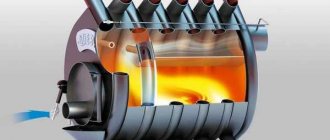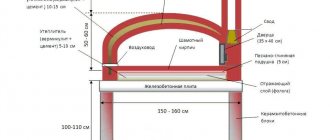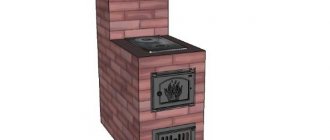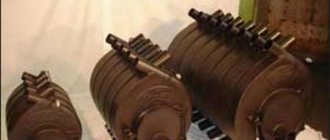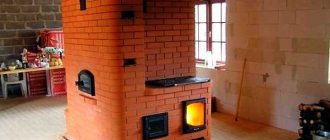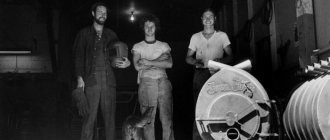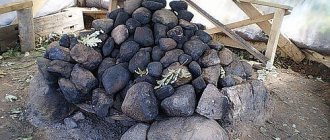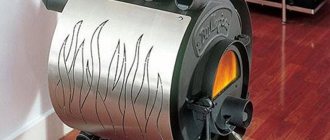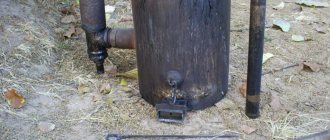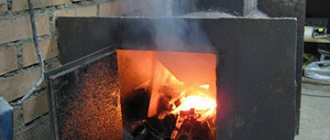Externally, the Buleryan stove resembles a potbelly stove with a fancy design. But the efficiency of this device is much higher, and the scope of application is wider.
Industrial production models are quite popular, but by making a Buleryan stove with your own hands, you can provide heat for a garage, outbuilding, or even a small house. Agree, the idea is interesting, and the savings on purchasing a new unit are quite noticeable.
In the prepared article you will find all the necessary information for constructing a heating unit. We will tell you how the Buleryan stove works and works, describe what materials and tools will be needed during the work, and also provide step-by-step instructions for making a homemade product.
In addition, the article provides practical tips on arranging a chimney and maintaining a heating installation. By following our recommendations, you can organize efficient and safe heating of a small room.
Design and device features
The Buleryan stove consists of the following elements:
- a combustion chamber formed from bent tubes and strips of metal;
- secondary combustion chamber;
- back wall;
- front wall;
- fuel loading door;
- chimney pipe;
- ash pan;
- injector;
- chimney damper;
- power regulator;
- blower, etc.
The back wall is made of two sheets of metal separated by a small space. This protects part of the device body from heating up to high temperatures, and also increases the overall efficiency of the furnace. In the secondary combustion chamber, combustible gases formed during the smoldering of fuel in the primary section of the combustion chamber are burned.
Before starting work on making a Buleryan stove with your own hands, you should study its design and operating principle in detail (+)
On the front wall, in addition to the door, there is a handle with which you can regulate the amount of air entering the chamber. The chimney damper performs similar functions. You can use only one of these elements to control the combustion process, or use them simultaneously.
Dimensions of the ash pan, i.e. The containers for collecting ash are small, and this is quite justified. If the Buleryan stove is started correctly, then during operation the wood will burn almost completely, so a minimal amount of ash will be produced or there will be no ash at all.
Several important elements are mounted into the front door. It is assembled separately and then hung using welded metal hinges. To increase the efficiency of the device, some manufacturers cover the Buleryan stove with a double casing. This is not a mandatory, but desirable element in the design.
If you have enough sheet metal available, once the basic assembly of the stove is complete, you can weld curved pieces on top of the tubes, which will hide the tubular “fins” and make the device safer.
Image gallery
Photo from
Factory-produced Burelyan stove
Modernization with additional elements
Wooden barrel styling
Home fireplace made of buleryan
Structure of the Buleryan furnace and principles of operation
The stove has an original design, in which everything is subordinated to the main task: quickly heating the air in the room, and then maintaining the temperature.
The furnace body consists of parabola-shaped pipes, between which strips of metal are welded. The pipes are mostly located inside the firebox, protruding only 1/3 of their diameter. Such a system is a highly efficient heat exchanger in which air acts as a coolant. As soon as the furnace is ignited, air is sucked into the lower ends of the pipes, which takes away most of the thermal energy from the heated metal. This flow is very intense. During active combustion, 4-6 cubic meters of air pass through six pipes per minute, and its outlet temperature exceeds 120°C (up to 150°C).
Active combustion is not the main operating mode of this stove. Most of the time the fuel is smoldering. Then the air in the pipes is no longer scalding “only” 60-70°C, but the body temperature is around 50°C (of course, not immediately after the “buildup”).
Cold air is sucked into the lower pipes, and heated air comes out from above.
The firebox inside is divided into three parts: the bottom ¼ part is separated by a grate, and the top ¼ is also allocated for the afterburner. The grate is either a standard cast iron grate or a steel grate made of steel at least 4 mm thick. The upper partition does not reach the door by about a quarter of its length. And this is not a solid sheet, but with holes. Through these holes, air from the furnace enters the fenced-off afterburning zone to maintain combustion of gases. The area of the holes is about 7% of the total area of the partition.
At the top of the rear wall there is an outlet for exhaust gases. A damper/damper is installed here, which has a smaller diameter (the gap is approximately 10-15% of the chimney diameter). Additionally, a 90° sector is cut out in the damper. This device allows you to regulate the draft, but the existing gaps will not allow carbon monoxide to enter the room at any position of the gate. This will not happen even with the door open. Then, however, the room will freeze completely, but safety comes first.
Further, in “Buleryany”, from the pipe there is not a chimney directed upward, but a horizontal section of the pipe, in which the unburned pyrolysis gases cool down a little (this is intentional). Then the chimney bends upward. Here the “branded” Bulerjan has an economizer. This is a heavily insulated section of the pipe in which pyrolysis gases from the furnace are periodically burned. Read about pyrolysis boilers here.
Factory-made Buleryan with economizer
Here's how it works. Partially cooled gases pass into the insulated pipe section. A certain amount of thermal energy has already accumulated here. The gases heat up again and flare up. Due to the increase in temperature, they expand, and since there is nowhere for them to go in the pipe, they clog the chimney. A gas plug forms (this phenomenon is known to stove makers and owners of their unsuccessful creations). The gases burn out and cool, the plug dissolves. For some time, the furnace operates as usual until the required amount of heat accumulates in the economizer. This process is spontaneous. The frequency and duration depend on the characteristics of the firewood and the position of the dampers.
To regulate the intensity of fuel combustion, there is a throttle in the stove door that blocks the air flow. The door itself is usually round and large in size so that large logs can be placed - this is the best option for smoldering mode. But this is not the most important thing. It is important to ensure a tight fit of the door: combustion products should not leak through it. This is also the difficulty of making pyrolysis ovens with your own hands.
We seem to have figured out the design and principle of operation. Now you can begin assembling spare parts and components.
DIY process
Considering the design of the device is not the simplest, it makes sense to draw up a drawing of the Buleryan stove in advance or find a ready-made project, for example, on the Internet. You will have to do a lot of cutting and welding of sheet metal, which requires a welding machine and skills to work with such equipment.
To successfully cut metal, experts recommend using patterns.
To cut sheet metal parts, it is recommended to use cardboard patterns to accurately maintain the dimensions and configuration of the elements
The main material for the manufacture of the Buleryan stove is sheet metal 5-6 mm thick and metal pipes with approximately the same wall thickness and an outer diameter of 50-60 mm.
To give the tubular elements the desired configuration, it is advisable to use a hydraulic pipe bender. To check the position of individual elements relative to each other, use a construction hydraulic level.
For the normal flow of the work process, you will need a number of other devices and materials:
- electrodes for the welding machine;
- pipe cutter;
- roulette;
- marker;
- clamps;
- square;
- ruler;
- Grinder.
They usually start with cutting metal and cutting pipes. Then the remaining metal is removed, and the individual elements are welded together, gradually assembling the furnace.
You need to cut the required number of tubes (for example, eight pieces, depending on the specifics of the project) with a length of 120 cm. Using a pipe bender, they are bent to a radius of 225 mm. The elements of the rear and front walls, doors, regulators and strips for the housing are sequentially cut out of a sheet of metal.
Tubes for the side walls of the Buleryan furnace must be laid on a flat surface and their position must be fixed using wooden beams
The remaining metal is used for the manufacture of door elements, ash pan, pipes, etc. Blanks for the V-shaped chamber are made separately. The metal strips for the body are cut with a width slightly larger than the outer diameter of the tubes. Oval cuts are made at the ends so that they can be welded tightly to the tubes.
The side air ducts are connected at the points of contact by welding, then I install a V-shaped pan inside to separate the secondary combustion chamber
The inlet and outlet pipes can also be made from strips of sheet metal, bent into a ring. An alternative is to simply cut pieces of suitable length from the metal pipe. But its diameter must be larger than that of the structure used for the device body.
Assembly of the device begins with tubes. The correctly bent elements must be laid in a checkerboard pattern so that the back side of the structure is at the bottom and the front side is at the top.
To ensure that the pipes are in the correct position, wooden blocks with a thickness equal to the outer diameter of the metal elements are used.
Bent strips of metal are applied to the side tubes and first welded in some places, and then a continuous weld is made
If the pipes are cut and bent correctly, it will be possible to lay out such a “pyramid” on a level base without any problems. After this, the pipes should be welded to each other at the points of contact.
The resulting structure can now be turned over and a V-shaped pan can be welded in the space between the “ribs”. It will separate the primary combustion chamber from the secondary. An injector should be made in one of the front wall tubes to supply air to the secondary combustion chamber.
A hole is made in the side tube into which a narrow injector is welded to ensure air flow into the second section of the combustion chamber
After this, you can continue to form the stove body by welding the previously cut strips of metal to the ribs. The optimal option is when approximately two-thirds of the pipe diameter is recessed into the body, and a third of these elements remains outside. You will have to tinker with the manufacture of the front wall of the stove.
In the front wall of the Buleryan furnace, a fairly spacious hole is made for the loading door, to which a small side is welded
In the blank for the door, first make a hole for the blower. A pipe is welded to it, in which a damper will be installed to regulate the flow of air entering the primary combustion chamber.
For the damper, you need to cut out a round part, the diameter of which exactly matches the dimensions of the pipe. A pin is welded to the damper. After this, a hole is made in the pipe along the axis into which this pin is inserted.
If the elements of the Buleryan stove are cut and laid correctly, the finished body will look neat. During assembly, you need to control the position of each part using a building level
A hole is made in the blank for the front wall for the door. A narrow strip of metal is welded to it around the circumference.
You need to weld two such strips of metal to the door itself, one along the very edge, the other should be inside at some distance from the first. If everything is done in accordance with the drawings, then the “collar” on the front wall will fit exactly into the gap between the edges of the door.
Two sides are made on the round door, between which the side welded to the front wall of the Buleryan stove must fit exactly
It is recommended to lay asbestos rope in this space to ensure maximum tightness when closing the door. Now you need to weld its inner part to the door, as well as the hinges on one side and the eccentric latch on the other.
The eccentric lock ensures a tight fit of the door to the front wall of the stove for maximum tightness, which is important during long-term burning of wood.
A damper with a damper on the door of the Buleryan furnace allows you to regulate the amount of air entering inside in order to establish the optimal operating mode of the device
It is better for an inexperienced craftsman to order this element from a professional turner. Hinges and a metal pin for the latch are also mounted on the oven body.
Now a double back wall with a hole for the chimney pipe is welded. This element is first applied to the finished structure to make sure that its contours exactly match the outlines of the pipes fastened together.
In order for the dimensions of the door to exactly match the parameters of the hole on the front wall, it is recommended to first weld all the necessary elements of the door and “try on” the dimensions of the side of the loading hole to it
At this stage, you can cut off the excess without any problems. This also applies to other elements - before welding, they are checked for consistency and adjusted if necessary. Now the oven is almost ready. Four legs need to be welded to the body. They can be made from bent pieces of thick wire.
Manufacturing an eccentric latch for the Buleryan oven door requires great precision; it is better to order this element from a good craftsman
The legs are welded to the front and rear walls of the housing. The finished device is installed on a flat and durable base, covered with fire-resistant materials: asbestos, smooth slate, ceramic tiles, etc.
It would also be a good idea to protect the walls around the stove from exposure to high temperatures.
The legs for the body of the Buleryan furnace can be made from very thick wire or bent thin tubes. It is important to give the device stability and correct position
Now a pipe is attached to the chimney pipe and secured with a coupling connection. In this case, the pipes are installed in a position opposite the direction of gas movement, although the manufacturer recommends doing otherwise. It is recommended to insulate the chimney, for example, with mineral wool.
Metal hinges for the Buleryan oven door are not difficult to make yourself from available materials and weld in the required place
Buleryan from a profile pipe
For the manufacture of the structure, profile pipes measuring 6 by 4 centimeters are suitable; it is with this diameter that the round pipes were installed in the original stove. The thickness of the metal in the pipes is at least 3 mm. A larger diameter will require copious amounts of firewood to heat the room and will cause a decrease in the efficiency of the heating system. To make the frame, you can use iron sheets 5 mm thick. The method of manufacturing a structure from a profile is completely identical to manufacturing the same system from round pipes.
Scheme and drawing
When welding a heating system, you can either bend it or weld it from blanks; the main thing is to respect the general structure of the stove so that it works correctly. Below is a diagram of the Buleryan furnace in section made of round metal pipes, instead of which profile ones .
This type of design involves the use of curved blanks, which simplifies the assembly of the whole system, but complicates the manufacture of the blanks themselves, since not every owner is able to bend profile pipes.
To make a Buleryan stove, the following materials are required:
- Profile pipes measuring 60x40 mm, metal thickness 3 mm, 7 pieces;
- Sheets of iron 5 mm thick for covering the skeleton of the structure;
- Iron sheet for the partition in front of the chimney, 3-6 mm thick;
- The pipe section for the chimney is at least 120 mm;
- Metal materials for the door, front wall, back wall (sheets, handle, round pipe);
You can additionally add various details to the external part of the system to visually give the stove a more aesthetic appearance.
Tools
For successful and convenient work you need the following tools:
- Grinder and metal wheels;
- Welding machine;
- Measuring instruments – square, tape measure, ruler;
- Pipe bender - if necessary;
- Marker for marking.
Step-by-step instruction
- First, 7 blanks are made from a profile pipe, as required by the project for convector heating:
Headers made from profile pipes
This is how they weld together
We weld all the other pipes
We weld metal sheets
Helpful operating tips
“Incorrect” installation of chimney pipes is due to the need to protect the structure from resin, which is formed as a result of the combustion of wood. If this moment is not provided for, then the resin will flow out of the stove, and with such an installation it will remain in the chimney and gradually burn out.
Upon completion of assembly, the Buleryan stove is installed on a flat and fire-resistant base and connected to the chimney. In this case, it is necessary to comply with fire safety rules
Clogging with resin for the Buleryan stove is almost inevitable. Over time, resinous layers accumulate and clog the device. This is expressed in a noticeable reduction in the efficiency of its operation, a decrease in traction, and problems with the free movement of the gate. So it's time to start cleaning the oven.
A lightweight version of this cleaning is to heat the device with aspen firewood. Unfortunately, the practical benefits of such a measure are small and short-lived.
The best way to eliminate resin contamination is burning. To do this, the stove is heated strongly with the ash pan open, essentially calcining all the channels. As a result, the resinous deposits burn out.
Based on the Buleryan stove, you can organize an autonomous heating system:
Image gallery
Photo from
Burelyan as the basis for autonomous heating
Air heating basis
Connecting their corrugated air ducts to the furnace pipes
Water heating device
Some craftsmen use oxygen to burn the furnace, bringing the nozzle of the cylinder to the opening of the ash pan. This is an extremely dangerous operation that violates fire safety regulations. Careless handling of an oxygen cylinder near an open flame may cause an explosion.
As fuel for the Buleryan stove, you can use not only firewood, but also wood waste (shavings) or special briquettes. An important condition is low fuel moisture. The less moisture, the less resin is formed inside the stove, and the less often it will have to be cleaned.
During operation of the furnace, you need to select an operating mode in order to obtain maximum heat with minimal resin formation. If the best option is found, cleaning will only need to be done a couple of times during the heating season.
Homemade buleryan: a detailed guide
First I bent the 57mm pipe. To do this, I used a special tool - a pipe bender. I cut the pipe to 120 cm, and then bent it with a 225 mm radius.
Bent the pipes
As a result, I ended up with 8 pipes. According to the design of the buleryan, I installed 4 pipes on each side, arranging them staggered. As a result, the depth of the heating unit was 45.6 cm.
Then I made a "T" bend. I will then install it behind the Buleryan. This design will simultaneously remove smoke and collect condensation. Test it at the end. If everything is done correctly, the smoke will go up, and the condensed moisture will flow down.
Improvement and modernization
Homemade Buleryan does not have an attractive appearance, so it can ruin the atmosphere in the room. Often, in order to correct this problem, the structure is refined and modernized by welding designer parts or various forged elements onto the skeleton.
If the heating system is installed in a garage or greenhouse, then it is not necessary to improve it, it will not spoil the aesthetic appearance, and efficiency can be lost if the furnace is unnecessarily modernized.
